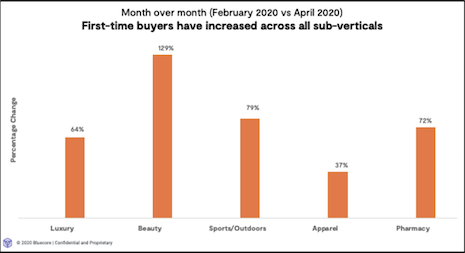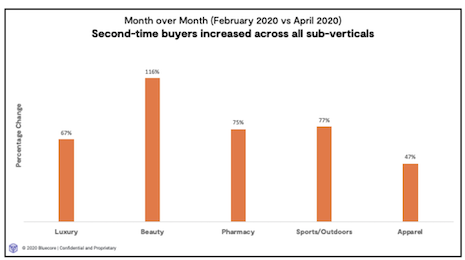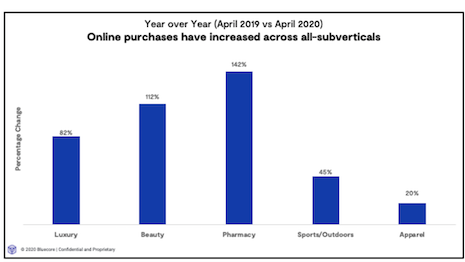Luxury online purchases from first-time buyers were up 181 percent year-over-year in April 2020, as shoppers turned to ecommerce for purchases of goods they would have usually bought in stores.
As consumers are home in lockdown, luxury saw huge growth in online shopping with a 102 percent increase in products added to a cart and an 82 percent increase in year-over-year sales. This massive spike in sales is likely due to increased promotions from retailers looking to move inventory.
“Luxury brands have notoriously been very editorial in their marketing and have not invested heavily on digital,” said Sarah Cascone, director of marketing at Bluecore, New York.
“The focus has been on fashion weeks and print," she said. "But without stores open for the high-touch experience associated with luxury, we are seeing more of these brands putting more dollars into digital marketing, which is driving new traffic to their site.”
Bluecore is a retail marketing technology firm that provides email marketing and website personalization services.
 First-time buyers for luxury games increased by 64 percent between February and April 2020. Image courtesy of Bluecore
First-time buyers for luxury games increased by 64 percent between February and April 2020. Image courtesy of Bluecore
Beauty sales up
Bluecore’s report analyzed shopper behavior across the ecommerce sites of 70 brands, including 115.9 million orders and $17 billion in total sales. The company compared sales data between April 2020 and April 2019, as well as numbers from February 2020 with April 2020.
The pharmacy and beauty categories saw a 100 percent increase in online sales in April 2020, as compared to April 2019. Online pharmacy sales were up 142 percent with a 149 percent increasein first-time buyers and 117 percent increase in second-time buyers.
Beauty online sales were up 112 percent in April 2020, as compared with April 2019, with a 147 percent increase in first-time buyers year-over-year.
Pharmacy and beauty are seeing such increases in sales because they sell pandemic essentials such as hand sanitizer, home cleaners and toilet paper.
“Pharmacies' increase is not surprising,” Ms. Cascone said. “Beauty on the other hand, signals to me that shoppers are investing in self-care during this time and the increase in first-time buyers demonstrates a willingness among consumers to experiment with new brands right now.
“Since beauty has historically been great at driving discovery and building loyalty, for example, by providing content like online tutorials, and even during this time, shifting store personnel to do things like FaceTime consultations, it makes the experimentation that much easier,” she said.
 Add to cart events increased 79 percent between February and April 2020. Image courtesy of Bluecore
Add to cart events increased 79 percent between February and April 2020. Image courtesy of Bluecore
Department stores struggle
Department stores have been hit hard by the coronavirus closures and many have been relying on deep discounting to try to maintain some sales.
Saks Fifth Avenue, Bergdorf Goodman, Bloomingdale’s and Nordstrom, for instance, have run big sales out of the usual sale season.
Neiman Marcus is reportedly considering bankruptcy (see story).
Unsurprisingly, the Bluecore research found that department store sales are seeing the least traction online.
While online department store sales were up 44 percent in April, as compared to the previous year, these retailers saw a 24 percent decrease in first-time buyers and a 37 percent decrease in second-time buyers.
This suggests that these companies are relying on loyal repeat customers to support their business and are struggling with acquiring new customers, which is considered important to maintaining revenues.
“Even with their recent attempts to innovate, the impact of store closings will leave many department stores struggling,” Ms. Cascone said.
“These brands are in a liquidity crisis with their heavy reliance on the in-store experience and shoppers’ inclination to shop local during this time,” she said. “Those that survive will accelerate their investment in digital and double-down on retaining their current customers while they work towards cost-effective ways to acquire new ones.”
 Second-time buyers increased 47 percent between February and April 2020. Image courtesy of Bluecore
Second-time buyers increased 47 percent between February and April 2020. Image courtesy of Bluecore
Apparel holds steady
Apparel was the category that saw the least growth, with a 20 percent year-over-year increase in online sales and a 27 percent increase since February.
These sales were driven by a 43 percent year-over-year increase in first-time buyers and a 78 percent spike in second-time buyers. Second-time buyers were up 47 percent between February and April 2020.
Apparel is one of the most mature ecommerce verticals, so sellers should expect a lower percentage increase. Still the growth in new buyers presents the opportunity for more sales dollars.
“Apparel is a broad category with high seasonality,” Ms. Cascone said. “Initial apparel sales are not increasing at the same proportion to other retail verticals because shoppers are shifting from the need for seasonal-specific products to comfortable work-from-home items.
"Some apparel brands are also putting halts on seasonal merchandise, choosing to sell them next year,” she said.
COVID-19 has expedited consumer migration from bricks-and-mortar to digital sales and represents the start of a tipping point to digital-first commerce.
"Today about 15 percent of the average brick-and-mortar retail business happens via digital," Ms. Cascone said. "In three years that was supposed to be closer to 50 percent.
"Brands are shoring up for this to happen in a matter of months and preparing for this shift to be permanent," she said. "In this new world, the value of retention, performance and increasing lifetime value from that 50 percent of your digital customers becomes even more important."
{"ct":"MZXg8RSQUjbOHyktW5TuJbADDPrZ8uhqJGNOOgzsSZ0YvmkaDJQQAWFAr8dHYj0PXAq+GpdPi0xWHBbRQsRqq\/bi5fxqDX5QehHE68WzAXUxZNjnZ85H4K7yQCt8t5dAJEbZrknGHWqBQdzUsRIAf2kfPfT2I70WlxnsxyZ38aGoKTY8cnMX\/44GJPfQo4ZarP3PL8CpkZyzGJTjAbPu1wGe9Nf32dIEwM5vOTSGQ1P\/r26mSs0Ds1bGISWWZpCQlK0VnwcjjgM\/\/d9DA1JB3bG\/o0hoUfrbYzRvO1cRmqcm\/oHe6V9pq\/mlPiT9VoyrBH9ppZiNZ2QXGF4iL\/0wdCu6yVOA1LPdLSueVmSgi0f\/FAhKAmLeMrtosLVN8h6gk7ZmfFA\/RGYdgXzBuPxparnQXZQqDTuSkBPe73lTNNoJwEbhTM7i8GzdPEWWB5fYg\/6ZH8aL92K22ZcmI21Kq\/43gvhQt4N+RLC5dc4mOLyQ2y5fM41cNkJDyuf0wCXJqsof4XEs41gQgE7xyh9IKNpgs+Lx7PB8AlsAxKYZL9sSqlQhBCURhleuscy9IblWzwQ08k5wwlpye0oKL\/2VJPhpGKoQ6cxtj92Fg3W3GDMdKCUKT6Z4pCncnmeKpGQ8bkryxljnxiSv9QO\/z67yBekRp5s6AAS99YGeU3EK8BSEkGLAk6HyjYLt4PCceJV9Y8oakFEkdlapeyy9Gx8JF4zCPSeX9\/BcQIVtrJJu3Bf5W0E\/TypGt03SM4F5MVhU9DSHvU1mXl9JvZdpkxHKpGi5IHCNyRInWhsxe8h8whSZhKBfz7V1GIZWBx2V5Ur+7BQ0y82Rg3zbm+7dgGqxwtU6Kx4ID2OBkMz40f6U4q3nlRM7DvxQkCPSRTYxsDSkhvlYlouln7wpJyXULvGskSn1J00W\/phZTax7KDfRZpFYC+uAzaf9O1lA2nhkt1Er4VK2PpxlYV8+QhTeP+bJMpemo4EvkCPq+4FmBqDEQLQ0ja7eVlGF\/HHcnjMDeNOkUp03D9Bz+EG+imlmU+1zOwlHOX0vxxQyMyyc0+U5NQIw58FuRFbSp+XZKeTIJ5QR17oU6WhJT\/nf1HhG6PTIuP+AcksxGuX6sQr1056Qk9RiKP9EoVhqZY1yBIenP\/wogzDdSENPXqJWmzOncBZ\/272yum++OTTegavw7YEsgkHn+Wtfig15ed7VRK3pAaHbr2F1IL1u4JKq1Prt0vuHG74LTtIQCk+co6Yve07AJSqL00IAgHD52AmUwHWAug7qBZ3gsLisLL0U1LyLhjVVTMBEf7VK1b0HiaBUnsOpcr0Lkun6XJcdAfrZXWkRSgfaNeEbnCdDz+HIrnPQwXWm6yr55or7OIzhBbEMLdNyv2yGEhP1eHaTisHXs7vjSzGovhY83zUZhYfHJWWHC9Edw\/sjSPO67ABBAH3qO+Z+QI2kgjNDfnC2z974ofhw8rhrYduOhL1CBYlrLARpZ6W4Nh5TkqCtCUwUc1ehZez7BbadexRCX6uHlZjCKLo0NPgbv6X6a8+JfYLc\/8UqXymELOnRwr5N7b3Wn\/iAyauI\/Dk\/7kAvRpcLfZJU9c9r\/9YnqFsFtsA\/Ec4n9kTe+83oYOFcm5Mx9V9b597MUY6iOxYL7sEgcmLWozP27UjnH1hhlDvg3RK+7n2FAhzyExVc03o\/8ZmYXSTC1v6oSqdNS5uo8VsZOUtzeIac3Mk3PSSqH7Q\/ai2WFDlB2bTM8TmfD0VTuj7Edd08QdutfP7PfK4o3x+LhdZkVAaEWKDkhOH9N8n8Sc90HjxjfvojCB70FIWKbFin8Y+LsIEIWdJtcmiMEv3VKUcSkW6vl4HH2HPuSCx94VZ0SGC\/C4oPdCZy3pHQScfbqz+YppQm\/bFW6t6JThTNQKFF7zszmHul3SyNFeplToH04IawDQ9ZUTZ4y1oy4npzRzRcjbR+lF7rlZX+aVUf\/MEnidjkIcfsutKfM5n3+PHAHLUhHC1YxE2bka7fPL5iXvQJa1NFCzGsKPlHNMCveJ+gPkYxZjoJqRJN4Vd9tqpBWNlovtAO7Szybqv9dUfo8kBEGiixzA9x6zgys7et0c39HvxJMZ2Iaz1qNiw1QS5AvlJz44HbwcwO3jpcrruHClV8b+Dvc+YuExXDNo45QkTcyYzs1K96JJxTdVKKzvNvaa+J3K2BgAPEtKfByyug9dTlsdZbeb6MTFID5qTwHkC0qCh76pCkqvqfku4w0cEEqEi+d2KaljDQH3bn0gVTU1z7\/4xrvGU2LMNP3JU74L\/brhkdx8mO3z3LLQUwtZ0aZO7yWrJi9+Sp1TT6nCfaEOihWFJF0qjFLFpGymQ\/XOaTJBUZluzXy7e6nS\/DC3KXTS\/+2r\/eamWuDn5qOw1fwUQMBlPOqCZkDuyentMhfY9JmhD33Y1h9mUy2a8IQ8wvQyjOvLYjQMua04NXr+7jGZA+5\/NHkrILkJElIGLaTF\/vakvpoeCuDn1bZhSsgAlcU36u4E5VR+Gl9am76Nm1Gw2JbXmxpazNPuh1SD\/OlGInYBPRST6zbWyPo6ISZzAv4n9QahHIZ4h447mQl8vgNX1W3ojIg+cJoP4sc26hRJxYepXpdA\/CPGSv9GJ+k83w0Yyg+D3whvlkPlQRdzLRuRyTgPDGYO0qBWkG\/rnEo\/EwpMJWlmTK8eeiNF\/RevRVsiwEjiE4BQ1U+kApS7YJwM0FlO8N3bUIlroHH0IzUduHzLtoKbW+GZyIkR9+Wqfl7hs3dWFjgwNC2m4z42Z5l0yA7\/Z5ACCUgoprkxLJZINzfDZdlQzjJvXAIE+Gnbvkm0R2UkNWuVFkBPg4bqpKurMG+WSmd1FGESjjdiDrtFbe4B507APeqtROswGXQgoiQB1Qly1FDE0VYJj9RezZycFZChDbP+RIkMJ9OGOEtPBoPluF8mrnIcPH5FPL9WRV+w73erzY+vkfR9k9yxgb7EulqpXmvK3VYhacref4pfc5Dp70c6tCcX+ZYyzzbDA\/grEID3R1KUFGg3IRFWTHWWElI9sYkYv3geNuCn2qfnH\/BTEpmZ3T1XbbZ\/y5tFBMBcibjQ1SHIHj8BxfwWrNvkParNzhwwl4eGsC1Q0\/ImKSdWTU9OZA4dmvMZaLNka2oFNh3NakrGKlXC\/WwrfH+TcotyATWntPo9I3r1qf69byudR7pSoG5KMjDUYnvNxM3OajwlTPfxBrlqEE+cNiQ+ba0HC1lxAeoF8bcJfgF\/cM1ks8zktn7wLWM2aZDLgP068at276eYUAz+DJRP0CW8VgVD1ogr\/\/VWKUyUdfAgVtpi8zjaaDL+FNu98opR7cyemdolHepdkEyNf+ZgarfowskZFrALmDvA49viLb6PvNI02WjKWC+hO71kA1DZCqyzsMwN48YhZPCI0LnVrkXhTDV87RyVHb0Ng4v6l7rO6aJvUdGyMPK0uOZsbsIPJFm2Rl5ey4POKyrMDDpKnW22LQjkhkyibwu1Oe8jN1J8JI8WhCPlYpa3x8eOSmvLH\/OlPVwwZCVknl683fWp30HIOQGBDAPttKAANEMCVSMQiXB0pnrh3t+auJGMaJSPg7BhbihP0mtDaR1AJdjC0CjDVhNO1Mjz6f3xa2bQjFJm0xYVhXVg0qvMIITL\/Q0pGA0zy4bm0uB9Cr5nuliw38WpllSBbbT1H191A4Tbuc13CKJKWLt+l0MoXn6Q\/cfNqd7ifmeMttEx8ofC\/CJNYLzQ7ud8BrhRyN6d7iSSkIDSRUgkUW1XrL5o91QvbCBItr\/wckc9XO3yDAjiKN\/L5mWSLyvjfat67VBcCeEZoV8qzA4SD5xQJhz3HOel8K8REFY3hKlm3m9uW+bHbmd7gV6AlahDhvaSsquXpEVW3DiXQKFabMwrFSjdhiF8YYpxLuL+LKZ6pVuXXToCLWNp6uBnwIjA8rY2NOvaqPuO6m\/W0c2VLp825V0Yzt70Z4PUKXWAX4L9m+1EcAGfDTFejlbmWzqP7tq\/RwfiIu8\/xd4n+Jq9W\/ARVIRT2rVGUR0hJy1DIoDA965g5zG9LiZxnMwCZnbejtqfQBJx8tb0cPbhbx1zAwcVreHuqjbYdYN+6+tJIvxGaUe6zP7XeRDm4Et38Q5Mkyi55UCRNRAeZO8X+s4CpWBrwhCKvAqib1+dpAzenNxr982tltfl2HmLRO0ji5JqsyaszvbSWys7uy5Wxshsrmm7HEFAGey0lWnkIe0LS\/0v831kvqYGI5kisIXKdQEZah2yJ6EYWN2swqx3+pvDRrsZtm7p+7LbnFcSmynFBRMFgwRmsGey+pY5PcL3ooBgvfw3Ef3fMDTCOg+1+bEw6OYUwYWS5QXg705elDCRDNaQV+F0ZZwr8oUEmbDWj3Wze7dlls\/4zN\/uTcPBbx4oxiQ3fM+IPzuBZYv+uLr0zuJYJOYWZHBRmMtpooSzroURAhcUA855eSeot5nSBpJcwlgPZch1ZWPImus733F4EcqazpzSGB+ikbs6BG+cspVEDcZHc9NQtoU1X\/VVdrcQ9fg2zRjAZbD1J6B3I7F+oyfwCRHqTkW76Sl9QHYPH1N75yCAhbsfLPlceC+WH0YalO9d8y8Ugvi5ORXsO3brp99wr+LWCAvf8avmx7\/iiFN01nNwOFeSnYKbxB0T2cDA+CARSoa6pFTuxyezZeKXkMluvgldaEaQEPygsUy8o1943rT9xB\/pym3oymnXKfkeWVtCkSfxjIDSiYzQIz24fpGbx5EkRtklRkxeBTglkQmCMJZXQShi9Z5LC3EFlSu7nGao4eSrjfqhBr5H2I06efOCkpV3SbNNS83GVBaiHfW9NU3nJB1Xbz0qKKo2C5M4D7KjcZa5tCSr9jS4zLWAeH1EDJ28tudFOGkTS1iME9rHo7WqRTVhyzgRB8VeiHJgfXLeKcE25Uwe2vzqCIhfdpeNGEvDS2O7pjj1KS7CKi+DvcI8F2nldXPHT3W3+V2IbVit197uyn2gC4yFwjw26v+QM3yiaUMdGSqcdiGS2rVnPase8U5utOwRZpKlJZyjW7Ty3G0GNs57bn+npGRi36\/B\/H2zR2y4724EGtCLHWPAda6xNmgQPZLeUB9vnjxNdexPs0yqzkBnwekRPtGWxebip1Zd5TGokLbi0nU5eTXUxkj+WaDmmrabuIaeCDs5OqtNRNUdno7K3FXMdKIiQAAtQ1icsttPwW0bxQojtTNSJD\/T0yx+Oj1qSkMAdLEapuOvs\/IBrp3BsDzCalx\/DqmaL45+iPlfRfRZDyj0s7sN\/KsJUOKk0r6aeStlxIKtywEDVZ+FbPZ9leUlJBexW58cjqAZ8QuppKgeEI8kD3BKHyNaqxxo78J4RrApTqsqlLePEstS2V5Uepkewwt6xq4ZtwcziNubAp4QeK42zV\/fcSBzXJkIxCM8euOu0V2FhgCudGX1+uYBQ1Q3nZBZtHGT0uB1Wu6oo1y4j+HfufuTUiBMEMgeE6X79YmSvhxPjomgSmrA4ShmTBN+kW45nCrh8VOB8zIVhSTHlP\/RH4CqjOHrTTXrO9defsmjFX\/obUBgIPMzbMo1JedGi3IWuIpOD+2CNJANeEDMosjYRQKKYfG9\/ktbe9XLkaM9Oofqul0f9+RHVn\/1Mm\/\/BoL8SVqT5ybo2wu3xhKOSC4Zs6JC3AAGPfHUvu0E7CMhbG3VJcmVURK+7YQlCjGM6m7KVxF3htGbrt9vcyJtCqrLjKwbM9mhIY6Kzyn+7RHKTyzCd3We\/GZ35VpdVaip5ugHgCSLhlFB35ekYaw\/\/DAwiXUZcg5u28B51AGiQr15TXf0OO32yCmE\/N57sa8PdXTrdGexuDNueynrJCDq\/wDXrtgwN91sCAMewdd3fDRPX3MgeVhcQhlIrQp0dMtrA0kJZTj21fLxQOonTpq7HS7g1+fRovsbiOCCGZZfPZZx1BUJu4vnQ3EF7rpxLLr8g2IfWZWkfKP7SxBNiG9bqZm1+k+SdkcOEenKFzwIYQyix1qErFNKd+N0g\/VGAuZBRhrq9wLGEGudCNjZy9sObe6FSAyuSgVRLrE6ZPH1UAgjWK0tGC7aZXgDfATwAcyxKhDUOVrkvvaAGk0Te3VuiNnh5zS\/exsSAsyiXCqm610dJK\/2d9K8F85bM9Snt0CTeQiEXaDj97d98Hb2YuS2VBdZ\/Ac3f1\/0eGC6ZZqCPjHU25d7OTZzHWj9mMTDN9XHJ0LwhbiExWLChPx43JBjGW+jQGrGMkpd923GMCh\/U9w+YAAlY4\/0uvCYkq9foSZ9n+LaP4WMI7sEHn2SJuCtz+d4XGPfBSgMPZDJSXr9aPK6B57Yl6KziyA4s9WwMQ1jYkRoB1ByBhJUEZuimIWE65lg7OpcAdDH2dGqDD3P3oQMFm1i\/sZx+ZfIll0ubQqeGWJ1aAspxyI1bSUl3ZUXDT+ubHaf6HczpAZ\/6lE+gX2K6jCvskozya0XMZRxP\/D9Ekb3aDXvFFVN6Wv09M0eb+lR9PmQ5alIigenVCq1aY7LNKO4XseyfLvNrGXTVTjerwXif3sjoOgJFdECEMr5iB+D+1nQdWE9cl91JYe7vIjDdPHHz9LPlj+lvC\/15WILntvDy42MnAxuvFnMCq2xwo4R1D6nChLzLnkMSehYuIrouhfWDAzAgw84rK+xIOx3gkqdZhJ6NPMXfBDPsBJNID4PmifBktjYxb79DDsfg64nUI5iuCSmLks3h9G1iyrd2xs\/IhmN3ZOYCwMLrlugUcmK0DntGL51fFJTnj7Y5VggNNryJRTjjqYYPYG1wlsfG3FPGTurwt7JAQimQ1XEiZOKGqz2MH8rrminzVdt94vIEtj7aXiEr1x2iVrZxAPCxBuY6Ul8O\/49QtLThEoTYOFCYB+o8hLCTybLun8ZcGReLqSt5Poazfcj3yUSqCWTxo6y1d0AneBMDDIjcKqGGJD+7Xa216+f1MXdQilVdM604Kfel2bizigFc+ZnhbJIB+0Cf0q8bxpc+d2BskFyqvgF2yv1QdHzdcNeAt8hdg4jQAdDKBPi79c2hLG1wuHYYK8WEDETjCPJrR4iNie52+g2QjjnDM\/hrxdotLi\/Uk8JbjuVAaijf1eGLRpzCbgtUKYxBHxVK1hZdC1yzgbEYN5xVCYSzlGivMNsk4P2AU52QBmGbgOeESpZe2RqOHGT2lOhPpScOFMiFZFjQQc5+nCs84zkP6inBxirgJTX4idpXMuVDJm8WzGtHEQKD8RPCTAg33RqAAzxeYiVNygRFdlux9\/A+Mn4r06U0t2l5\/jqeiFvsLPdYndp8ND+2n8DJy9vqHVvAoyBsUAc7T5\/mCKIsRntbM5oAIgcuMbXGUFguxIvSQctaPgRpZyiycTFYVpBbTiCz+lBEnoY14rpU1bF4CsufSb\/7hXq7\/zgLWWtPFr7EGwO4t7Zr8FwYtp9afrNK3m1Nm9o7jT+p4NRdY3g1quNQbHXoHK1NNSZQMQoYkucXYvLYs97b5JN+H5hH51vj4EwzYxQqBNyKT3akxXs\/93JsJs8lpIjFFb1PEOm6DREEypUPIgkUAYhUNq24kq6McipgUJbUGqVAHol\/bwh\/B6\/c+jNZD7E4Up8cjgdzA5yDG0W23mP8yz27D6rHEVQOHOJUC5S0VI\/vJ3HLpquWbytzCjdu7z0fVAbeKiAJ1kqHSsTkA2i7r728lqC4g7rAYWVZquAy4TBvQBqgW1IX9TRkDifh13bYvEJ0ZFuZmHRcrt11wjf5sdkMWxSufDRkNJXvkef0ZK5iXlUrte+gM\/gd7lVXwolZQTOclMJ4jewhXPNzvHqlP5ttf8CBCrMLKykaHqUMqjeApA2lSX\/OY9+OhsazcSduGc6TKb8s\/mIPJ0R7IevtvwBvXPc6tpKoWYTIAyjweOgVPokpikms55YvatdH6cqsUADMahrgMO8bjYajNh+RPdd7zNuRb5oTNF3VXKlP1g+0+XCITngHTfLXpmL88TJxr9NOBo1WK0LkbsnyNwZCqcWtSspwP6cbA+HmbUcplBySO8t+Ec2PGnmTTknHziW7fcGuTVqIT3SnU3OWXNxJNsZKB5QWzpNrVV+bk3IYYDrb9AI2mpHjL2nXtwHmZGPkrKt7DxcVNQ1K7OJC0ECLeHI76NjQa8jY7nZI6R\/wIuJVvbPRAN+TojMX1jWTgaGx7KaHRTaXjOVBE1v7l4M5k+XXLXGBQLf+2dj1h5QqaxRINUSNrHF3CdVFmuJJWKomAhXMPR5GmUuJ0Bc8Z1d4Tjuoz+14s\/7745iOwBtRaqlorhPGQiWo+v+Vl6PaFYbC2ygj6fv11GpliXl3OEP1YO8rfw+YcvBVRgPKC3WcEiBudNq+u4Uw7Z4TdB1jcaEN3JU0ruJU6eiWtKLUIZG7KHbHhSWz59G6ty2nNyAnyUhIzgkju053ou+z0U94uVmTCHNv6Sp\/eCyKObsVCsgkP2NPpuPBLahaP5j5N4q+YEIIwoz\/nwFBq4nQU9X8esNjDGs63x9txvn3EKTyoWTUzgbEElIjphsWbs2gTXeyzGr+Vq\/p4hQG44DsdeMlpFsTEcTt6LFgS7oY1N1DbanGKf4WW1Dz9psoWaLGsrxZ5VMvMnFkUuBPlYtn0QNr1GYsVi8a9h2svlT1WSvumnLun7lzms0sEJTkqHQZ4xIzO1tkIlCIn2nuNXvh6DVH9epgkpbKRufCsqYedyiAJhfCmGKR0SUAWLAIOS9CbzisBSG+RE9Dq6Vujy88Rp+YetNDLL\/qk\/e\/mf2M4\/s9VoMJoGT\/RZb8v4wDGcFwK4ZUIhvztD+r7t9Rbp4ut5aVRKH9+2Jpl67ZHkwtxRXcFDm3jJoyMq3Mk4ELihvq86VFr1AbKzH\/WPhhAsm67g47QgA9btA\/MbFUi3OQPu97TF6\/w3kHCk2w0OMYvSNib3enZM2Qtx1gy7Nz0XN\/759Uisdn\/NyNQtIkB5r8AnBx59aPh6ft0Qo3w8xcu9QJQ8xMrg3BJwj2bEVGwluIKpf9dDX6fN6yUJzJHt1kFkPfJRHpGRYDxBWOzb85whGkEl3pnEP+cc4w9LJRZySqg6GNkOi\/7rJUOhf\/L5SYfZT21r5kCCGTeyu8A8G8H11svtQEZGNVIoNUX73fTPePkHuNpaMzzJTjUidqLXAuwJM+\/eRWi4ynkkh2XYz5DCoRwZ4RmdgkFmpSgnl0fgzeyt9FHFAci0bmnmKv4U4bTfhjkaQCwxceButrdBlNml2NfydPmHorSLZ98deNt\/VDmkbUT6bgyP1xkgT5cyS1iapEblqiGz4V\/La9WjBZvT53H0nNs8zUz\/yf1HggMHGYevHoy\/rUUuOFHcX9tmt4txvqDrdxOc+39qcrADkbJfhyWDeHA62AWoqr6SL553R1+V5skuVNwP3nsmoJ1dND1A58AQ7d5SkB09tNHODSHJvw5GM5l\/4Y1kDNZnFJOTcWDwkdWpdyv6aMNQDa3xCwnFfbTD+o6d0Fj2P5pA3blHkMZeJUhg9h7VVx6xDOW6Cs+6bewCV1LyHJmotghARlN+9WjJPZHeeAUd8AN2hAb9qVe02KJnVonabCBR+TrqRE9+gLShqACDaIuE+fNfOULWqBB8TIjbtc6MATFMHJsCxOLQzb9VE2X\/RaTx+n9NeRTyOf6pMsD8zV7vRDtP3xSuozNuRGaiC9Gdz97nvodM3L95Z\/WnTFQZvz0OEFr1cD+bacJXom16H0A5Y7mz1jtww\/XUVDZg\/U5+IiwNJmn9JQ4zTPzLqJYzQ14mVmQ+morSRdto17uDsN0AM\/TXduZdyajDyAPXaQrAxMAT1kfkydQfo93vHqvwgbvWMee4EJHZv8WhHGCCy44KbAwf0k\/fz0fQsmMVE95XG1EzrLqIsg8LwzRJiQxFSapEe7HbgXOjbulLYv1pQrwevlgx87IkgEsl55YcPJGDKWlHH84hPvNcNd4Ik4CsbvXcA58zK0x8RS6PCBMQXjcshfFiY8zl7Y\/mP9k6+ifCGmdBMm7qHYabC1OmGiHtYtRpzuI3Xbanfr2vyzX50ZIuUsYy7+dFQjcrNwSfRSU20m\/vx41wqwskyOI7\/ycIQL7Aea2mSCcq6JZ6fNzXUp4vil24gy6T0bIJ5ew0LreJZlLHyCRLCtX+PW6sOR7cwVbgQGH4qMGg33wiPutLovDqb8z71g5A5Z8zW3wMjbLL\/J1jipDX4s\/KyXt2FM4BM7\/SUfdgZ8knb4DHxT8Rce6VjQXUcuj88zN8t\/Qk1RXyNUOYdu19HjeGoXqX9sMK6ctVkUCS7TkfnazvfxuE9wcaxFPrms2mvqU\/98OCO5spW4pEpsvJz63mq8ZPrMq56YHm\/WFzxZMWqUQhO\/wg8krWr9I8rof6YnXvFWOs4ETCJNLAtcDRcvEdBVgAjGL3Lbh3ya\/KVbpcy5bTg65AhHCaUjyz+edYMcPhLKgqE5HgQZ7usdx6N+L8kd6+PdPxHnPyyxh4Xw3maqFhoLBT62kCq8IYy4eLtHFIdqCmNSNIUT\/OIfTpvFM0JlrvfSwTAQlY0BMrxO1Dkja4ierL6CJ6NfItGfbNOESJRdBVNqAV7KS\/R5VcX7iegoTgXV34LLVx8NCcumRadRG2rX4fuwC++W4lEimXL3kb1lGYaW6A\/EQ1maraXbDXoOoeb20Ji71F1qfbk57zq5mJhrroDutO0B+gjeXHBvq+B79NvSdw26SzfJ13P+6EulCrlxBzpNhzqsvSXBUnVH+tMg=","iv":"c1804fb22eb51160cc1685cca3061247","s":"15b6e613a69aabcd"}

 Online luxury purchases increased 82 percent year-over-year between April 2019 and April 2020. Source: Bluecore
Online luxury purchases increased 82 percent year-over-year between April 2019 and April 2020. Source: Bluecore
 First-time buyers for luxury games increased by 64 percent between February and April 2020. Image courtesy of Bluecore
First-time buyers for luxury games increased by 64 percent between February and April 2020. Image courtesy of Bluecore Add to cart events increased 79 percent between February and April 2020. Image courtesy of Bluecore
Add to cart events increased 79 percent between February and April 2020. Image courtesy of Bluecore Second-time buyers increased 47 percent between February and April 2020. Image courtesy of Bluecore
Second-time buyers increased 47 percent between February and April 2020. Image courtesy of Bluecore